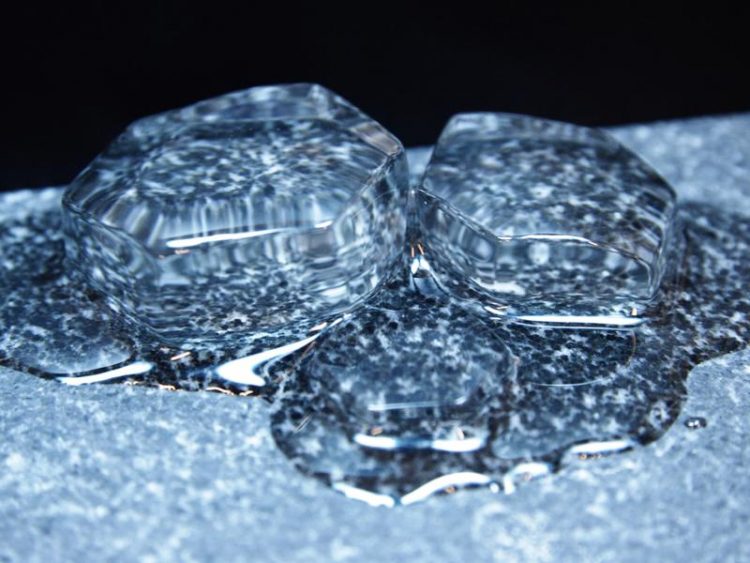How does water melt? Layer by layer!

Ice melts layer by layer. © MPIP
We all know that water melts at 0°C. However, already 150 years ago the famous physicist Michael Faraday discovered that at the surface of frozen ice, well below 0°C, a thin film of liquid-like water is present. This thin film makes ice slippery and is crucial for the motion of glaciers.
Since Faraday’s discovery, the properties of this water-like layer have been the research topic of scientists all over the world, which has entailed considerable controversy: at what temperature does the surface become liquid-like? How does the thickness of the layer dependent on temperature? How does the thickness of the layer increases with temperature? Continuously? Stepwise?
Experiments to date have generally shown a very thin layer, which continuously grows in thickness up to 45 nm right below the bulk melting point at 0°C. This also illustrates why it has been so challenging to study this layer of liquid-like water on ice: 45 nm is about 1/1000th part of a human hair and is not discernible by eye.
Scientists of the Max Planck Institute for Polymer Research (MPI-P), in a collaboration with researchers from the Netherlands, the USA and Japan, have succeeded to study the properties of this quasi-liquid layer on ice at the molecular level using advanced surface-specific spectroscopy and computer simulations. The results are published in the latest edition of the scientific journal Proceedings of the National Academy of Science (PNAS).
The team of scientists around Ellen Backus, group leader at MPI-P, investigated how the thin liquid layer is formed on ice, how it grows with increasing temperature, and if it is distinguishable from normal liquid water. These studies required well-defined ice crystal surfaces. Therefore much effort was put into creating ~10 cm large single crystals of ice, which could be cut in such a way that the surface structure was precisely known.
To investigate whether the surface was solid or liquid, the team made use of the fact that water molecules in the liquid have a weaker interaction with each other compared to water molecules in ice. Using their interfacial spectroscopy, combined with the controlled heating of the ice crystal, the researchers were able to quantify the change in the interaction between water molecules directly at the interface between ice and air.
The experimental results, combined with the simulations, showed that the first molecular layer at the ice surface has already molten at temperatures as low as -38° C (235 K), the lowest temperature the researchers could experimentally investigate. Increasing the temperature to -16° C (257 K), the second layer becomes liquid. Contrary to popular belief, the surface melting of ice is not a continuous process, but occurs in a discontinuous, layer-by-layer fashion.
“A further important question for us was, whether one could distinguish between the properties of the quasi-liquid layer and those of normal water” says Mischa Bonn, co-author of the paper and director at the MPI-P. And indeed, the quasi-liquid layer at -4° C (269 K) shows a different spectroscopic response than supercooled water at the same temperature; in the quasi-liquid layer, the water molecules seem to interact more strongly than in liquid water.
The results are not only important for a fundamental understanding of ice, but also for climate science, where much research takes place on catalytic reactions on ice surfaces, for which the understanding of the ice surface structure is crucial.
Max-Planck-Institut für Polymerforschung
The Max Planck Institute for Polymer Research (MPI-P) ranks among the top research centers in the field of polymer science worldwide. The focus on so-called soft materials and macro-molecular materials has resulted in the worldwide unique position of the Max Planck Institute for Polymer Research and its research focus. The institute combines all the necessary specialized expertise – from the creative design of new materials, from their synthesis in the lab to their physical characterization as well as the theoretical understanding of polymer characteristics.
The institute was founded in 1983. More than 500 international people are working at the MPI-P.
More information under: www.mpip-mainz.mpg.de
Publication in „Proceedings of the National Academy of Science (PNAS)
„Experimental and theoretical evidence for bilayer-by- bilayer surface melting of crystalline ice“
M. A. Sánchez, T. Kling, T. Ishiyama, M.-J. van Zadel, P. J. Bisson, M. Mezger, M. N. Jochum, J. D. Cyran, W. J. Smit, H. J. Bakker, M. J. Shultz, A. Morita,
D. Donadio, Y. Nagata, M. Bonn, and E. H. G. Backus
doi:10.1073/pnas.1612893114
Scientific contact:
Dr. Ellen Backus
Max Planck Institute for Polymer Research
Ackermannweg 10
55128 Mainz, Germany
T+49-6131-379536
backus@mpip-mainz.mpg.de
Media Contact
All latest news from the category: Life Sciences and Chemistry
Articles and reports from the Life Sciences and chemistry area deal with applied and basic research into modern biology, chemistry and human medicine.
Valuable information can be found on a range of life sciences fields including bacteriology, biochemistry, bionics, bioinformatics, biophysics, biotechnology, genetics, geobotany, human biology, marine biology, microbiology, molecular biology, cellular biology, zoology, bioinorganic chemistry, microchemistry and environmental chemistry.
Newest articles

NASA: Mystery of life’s handedness deepens
The mystery of why life uses molecules with specific orientations has deepened with a NASA-funded discovery that RNA — a key molecule thought to have potentially held the instructions for…

What are the effects of historic lithium mining on water quality?
Study reveals low levels of common contaminants but high levels of other elements in waters associated with an abandoned lithium mine. Lithium ore and mining waste from a historic lithium…

Quantum-inspired design boosts efficiency of heat-to-electricity conversion
Rice engineers take unconventional route to improving thermophotovoltaic systems. Researchers at Rice University have found a new way to improve a key element of thermophotovoltaic (TPV) systems, which convert heat…



